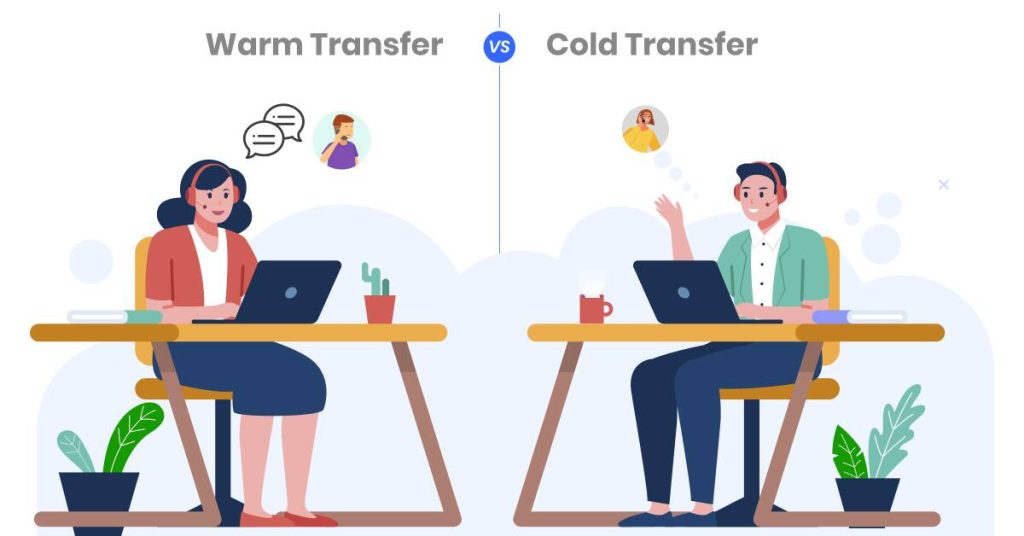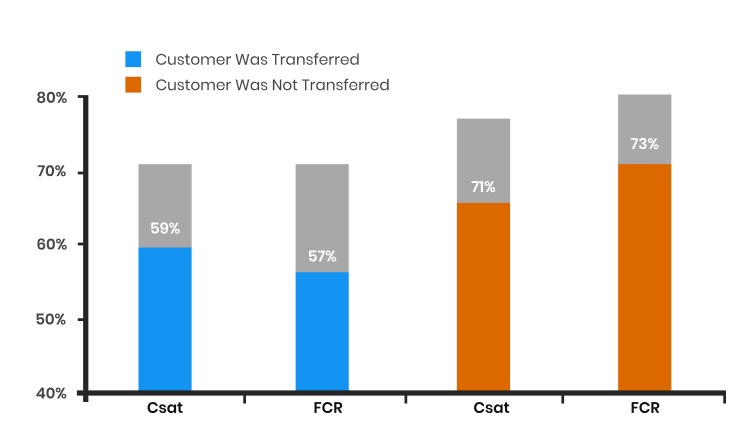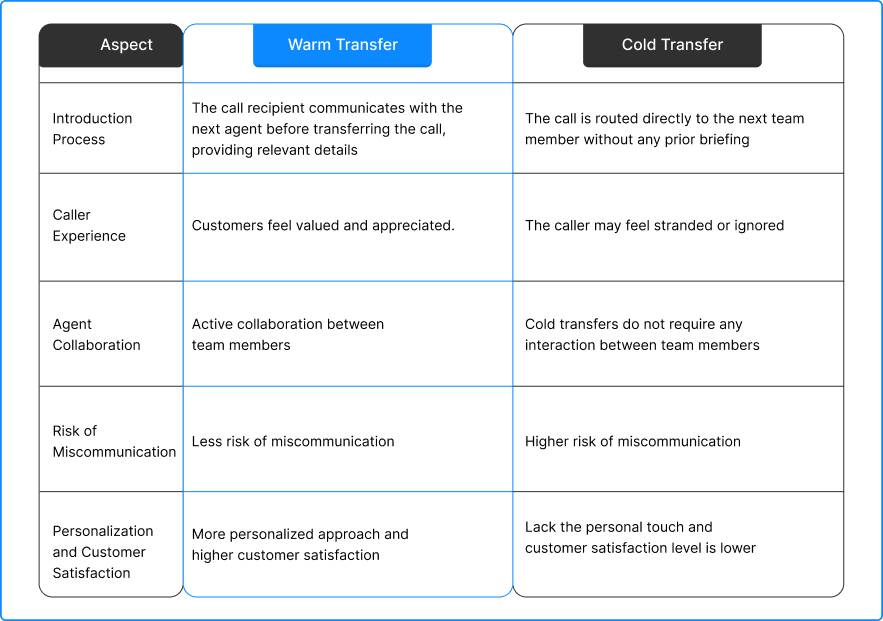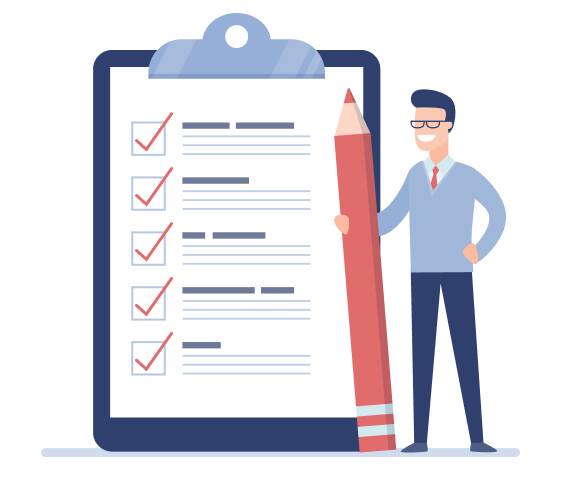
A recent Zendesk report shows that over 70% of customers want companies to have interdepartmental collaboration before transferring a call, and 68% get annoyed when their calls are transferred in the first place. It proves how essential it is to understand the concept of warm transfer vs cold transfer, especially if you are in a call center or customer engagement business.
Every phone call is an opportunity to strengthen the bond between a business and its customers. However, not all call transfers are equal. Imagine this- you dial a company’s support line seeking assistance, only to find yourself bounced around from one agent to another, each one seemingly less equipped to handle your inquiry than the last. Frustrating, isn’t it? This scenario illustrates the crucial difference between a cold transfer and a warm transfer, and why it matters.
When executed seamlessly, transfers can streamline the customer experience, efficiently connecting callers with the right person to address their needs. But mishandled transfers can lead to dissatisfaction, eroding brand loyalty one frustrated customer at a time. So, what exactly distinguishes a warm transfer from a cold one, and why should businesses prioritize mastering this aspect of customer service? A deep dive into warm transfer vs. cold transfer will uncover the answers. But first, let’s discuss what call transfers are.
The Concept: What is a Call Transfer?
Call transfer is a process in which an ongoing telephone conversation is passed from one person or department to another. This could involve transferring a caller to a different agent, department, or extension within the same organization. Call transfers are commonly used in customer service settings, such as call centers, where different agents or departments specialize in handling specific types of inquiries or issues. Transferring a call allows the caller to be directed to the most appropriate individual or team to address their needs most effectively and efficiently.
According to SQM’s research, among customers who contact a call center, 19% are redirected to another agent. When a customer undergoes a transfer, customer satisfaction (CSat) decreases by 12%, and their first-call resolution (FCR) rate is 14% lower compared to instances where a transfer doesn’t occur. Customers are most commonly transferred to another agent due to two primary reasons:
- The IVR voice menu system failed to direct them to the appropriate agent initially, or
- The current agent lacks the necessary knowledge, skills, and abilities to assist the customer effectively.

How Do Call Transfers Work?
So, how does it work in reality? Call transfers allow employees to reroute calls seamlessly from various devices, including desk phones, computer softphones, and smartphone apps. This feature extends beyond internal systems, enabling transfers to external numbers. Agents can efficiently redirect calls within the organization and to appropriate departments, ensuring effective communication and customer satisfaction.
Types of Call Transfer
A call can be transferred in two ways:
- Cold (blind) Call Transfer and
- Warm (attended) Call Transfer
In cold transfers, the agent redirects the call directly without any prior notification, while warm transfers involve greeting the customer, briefly placing them on hold, and informing the receiving agent before completing the transfer. The distinction lies in the level of communication and consideration involved, with warm transfers often providing a smoother and more personalized experience for the caller.
What is Warm Transfer?
Let’s talk about warm transfer first, would we? A warm transfer, which is also referred to as a soft transfer or attended transfer, occurs when the current call recipient communicates with the next agent before transferring the call. This ensures that the new agent is fully informed about the caller’s details and can address their needs promptly. During a warm transfer, the caller may be placed on hold momentarily, but they remain engaged through on-hold music or messages.
This approach eliminates the need for the caller to repeat themselves and allows the new agent to greet them by name and work towards resolving their query immediately. By providing relevant background information and confirming the availability of the receiving agent, warm transfers facilitate smoother transitions and enhance the customer experience, making callers feel appreciated and valued.
What is Cold Transfer?
On the contrary, a cold transfer, also known as a blind transfer is when you dial a customer service line only to find yourself bounced around like a pinball between representatives, each one more clueless about your issue than the last. It’s when a call is whisked away to another agent without anyone bothering to clue them in on your situation. No background briefing, no heads-up, just a cold handoff that leaves you feeling like you’re talking to a brick wall.
Unlike warm transfers, which involve a thoughtful exchange of information before the transfer, cold transfers leave callers feeling stranded on a customer service island, with no lifeline in sight. They’re impersonal, inefficient, and frankly, just plain annoying.
Sure, there are times when cold transfers might seem like the quickest route to getting a caller off your back. But in the long run, they’re a recipe for customer dissatisfaction and lost business. So, before you hit that transfer button, think twice about the kind of experience you want to deliver. After all, nobody likes getting the cold shoulder, especially when they’re just trying to get some help.
Warm Transfer vs Cold Transfer: Main Differences
While both warm and cold transfers serve the purpose of redirecting calls, they differ significantly in their approach and impact on the customer experience. Warm transfers prioritize communication and collaboration between team members, resulting in a more seamless and satisfying experience for callers. On the other hand, cold transfers may leave callers feeling frustrated and disconnected, highlighting the importance of choosing the appropriate transfer method based on the situation and desired outcome.
I’ve pointed out the main differences between these two types of call transfer here:

Are Warm Transfers Better than Cold Transfers?
At this point, a warm transfer seems much better than a cold transfer. But before narrowing down our thoughts, we should analyze the benefits of warm transfer vs cold transfer.
Benefits of Warm Transfers
1. Personalized Interactions
Warm transfers facilitate personalized interactions by allowing representatives to greet customers by name and address their specific needs. This personal touch enhances the connection between the caller and the representative, contributing to a more positive customer experience.
2. Positive Brand Perception
Providing cohesive experiences through warm transfers contributes to a positive brand perception. When customers receive consistent and attentive service from each representative, they view the company as professional and customer-centric. This positive perception can lead to increased customer loyalty and higher customer lifetime value. In contrast, inconsistent experiences from cold transfers may undermine the brand’s reputation and erode customer trust.
3. Cross-Team Collaboration
Facilitating the exchange of context and information among representatives, warm transfers promote cross-team collaboration. This ensures that all team members are briefed about the caller’s needs, enhancing the collective effort to address customer issues. By fostering collaboration, this approach boosts efficiency and empowers representatives to deliver comprehensive support to customers.
4. Efficient Issue Resolution
By transferring calls to the right agent or department, warm transfers increase the likelihood of resolving customer issues efficiently. By connecting callers with the most suitable resources from the outset, warm transfers minimize call escalations and reduce the need for multiple interactions to address a single issue.
5. Professional Demeanor
Warm transfers demonstrate a professional demeanor by checking in with the caller ahead of the transfer. This proactive approach conveys a sense of seriousness and professionalism, reassuring the caller and instilling confidence in the support process.
6. Happy Clientele
By making the call process as painless as possible, warm transfers contribute to happier clientele. By minimizing the time and effort required for customers to resolve their issues, warm transfers leave a positive impression and increase the likelihood of repeat business and referrals.
So, warm transfers offer a range of benefits. By prioritizing communication and proactive assistance, warm transfers contribute to a more efficient, effective, and enjoyable support experience for both customers and agents.
Benefits of Cold Transfers
If you can’t always find a suitable agent to warm transfer a call, you have to take an alternative way- cold transfer. Although this is not a good option in general, sometimes it might be the only one. Now, let’s try to find out if cold transfers have any benefits to offer at all.
1. Efficiency
Cold transfers are quick to initiate, making them preferred by call center agents when time is of the essence. They streamline the process of transferring calls to the appropriate agent or department, saving time and ensuring swift resolution of customer queries.
2. Immediate Response
Customers value prompt responses to their inquiries, whether related to customer service or sales. Cold transfers facilitate an immediate routing of calls to the right department, ensuring that customers receive timely assistance without delays.
3. Workload Management
During peak periods or “all hands on deck” situations, cold transfers help manage heavy call volumes efficiently. By quickly redirecting calls to available agents with relevant expertise, cold transfers enable call centers to handle increased workload effectively.
4. Departmental Routing
Cold transfers ensure that calls are directed to the appropriate department, enhancing the overall customer experience. This reduces the likelihood of callers reaching the wrong department and improves agent productivity by allowing them to focus on queries within their scope of expertise.
When to Warm Transfer vs Cold Transfer

When considering whether to use warm transfer vs cold transfer, it’s essential to evaluate each option based on the specific circumstances and desired outcomes.
When to Use Warm Transfer
- Complex Issues: When customers present complex problems that require specialized expertise, a warm transfer ensures seamless communication between agents. By briefing the receiving agent beforehand, the customer’s concerns can be addressed more efficiently, leading to faster resolutions.
- Emotional Calls: During emotional or sensitive conversations, warm transfers demonstrate empathy and understanding. By connecting customers with agents who can provide compassionate support, warm transfers contribute to a more positive customer experience.
- Escalation Calls: In instances where customer queries need to be escalated to higher levels of authority, warm transfers allow for a smooth transition. By providing background information to the receiving party, warm transfers ensure that customer concerns are addressed effectively.
- Specific Department Requests: When customers request to speak with a particular department or representative, warm transfers ensure they are connected promptly. This personalized approach enhances customer satisfaction and builds rapport.
When to Use Cold Transfer
- Urgent or Time-Sensitive Calls: In situations that require immediate attention, such as urgent requests or time-sensitive inquiries, cold transfers facilitate swift resolutions. By transferring calls quickly to available agents, cold transfers help address customer needs efficiently.
- Surge in Call Volume: During peak periods or high call volumes, cold transfers may be necessary to manage workload effectively. While warm transfers provide a personalized touch, cold transfers offer a rapid solution to ensure customers are attended to promptly.
- Out-of-Office Situations: When agents are unavailable or out of the office, cold transfers may be the only viable option to handle incoming calls. By routing calls directly to the appropriate department or voicemail, cold transfers help maintain operational efficiency.
By assessing the nature of the customer query, availability of agents, and urgency of the situation, call center managers can determine whether a warm transfer or cold transfer is most appropriate for optimizing customer satisfaction and operational efficiency.
How to Do a Warm Transfer?

Although the process of a warm transfer might be different regarding what dialer or platform you use, executing a warm (attended) transfer is simple and seamless.
- Within your communication platform or softphone app, click on the transfer icon during an active call.
- Opt for an attended transfer and select the intended recipient. Before finalizing the transfer, communicate with your colleague to provide the necessary context.
- Once briefed, complete the transfer to connect the caller with the designated colleague.
Efficiently manage active calls by using the pause icon as needed. This process ensures personalized assistance for the caller and effective collaboration among team members.
Warm Transfer Example
Imagine you’re in support and receive a call regarding a specific issue. Here’s how the call center agent might proceed with the warm transfer:
To the customer: “It would be best if you could speak with Sarah, who specializes in this subject. Allow me to transfer you.”
To your teammate: “Hi Sarah, I have Mark on the line, and he’s encountering issues with local promotion inquiries. I’m transferring him to you now.”
How to Do a Cold Transfer?
Doing a cold transfer is simpler than you might imagine. Here’s a straightforward guide to efficiently executing a blind transfer:
- While you’re on an active incoming call using a mobile or desktop app, there’s no need to put the caller on hold.
- Tap on the transfer button within the app interface.
- Select the person’s name from your contacts list or type their name directly if it’s not listed.
If you’re using a desk phone, specific sequences may vary based on your make and model. You can find detailed instructions in the manual.
Cold Transfer Example
Cold transfers prove advantageous in situations where the caller doesn’t require extensive discussions or background information, or when they don’t specifically request to speak with a particular person.
For instance, if a caller contacts the support line with a billing issue, the agent or virtual receptionist can promptly transfer the call directly to an available billing agent without the need for additional information or conversation.
Best Call Transfer Practices for Businesses

In customer service, the debate between warm transfers and cold transfers is ongoing, each offering distinct advantages. Warm transfers, in particular, often provide a superior customer experience compared to direct or blind transfers. Here are some of the best call transfer practices you can follow to ensure optimum customer satisfaction:
1. Identify Optimal Transfer Scenarios
Warm transfers excel in situations where complex issues require collaboration among agents or when callers reach the wrong department accidentally. This approach fosters seamless resolution without inconveniencing the customer.
2. Train Your Agents
Provide comprehensive training to agents on when to use warm transfers for complex issues or specific expertise and when cold transfers are necessary during high call volumes or for simpler queries.
3. Inform Customers
Keep customers informed throughout the transfer process, obtaining explicit permission before transferring calls, explaining the reason for the transfer, and managing expectations regarding resolution timelines.
4. Take Accountability
Agents should take accountability for any delays or inconveniences, apologizing for longer hold times, and reassuring customers of resolution to maintain trust and satisfaction.
5. Prepare Clear Policies
Establish clear policies regarding warm vs. cold transfers to guide agents in making appropriate decisions, ensuring consistency and reliability in customer experiences.
6. Consider Outsourcing When Suitable
Consider outsourcing to third-party providers during peak periods to ensure calls are handled efficiently and maintain high service levels.
Conclusion
Before wrapping up, I would like to remind you that mastering call transfer practices is essential for businesses looking to deliver exceptional customer service. Whether it’s a matter of warm transfer vs cold transfer or implementing best practices to keep customers informed and engaged, every interaction contributes to shaping the overall customer experience.
By prioritizing agent training, transparency, and accountability, businesses can ensure seamless call transfer and efficient issue resolution, ultimately fostering trust and loyalty among customers.




























